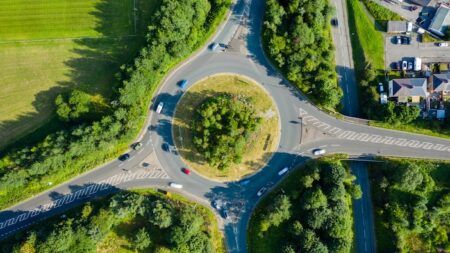Researchers at the University of Minnesota’s Center for Transportation Studies (UMN-CTS) have been developing connected vehicle technologies to help the state’s snowplow operators perform their jobs more safely and effectively.
As part of a multiyear project funded by the Minnesota Department of Transportation (MnDOT), the most recent UMN research has studied driver-assist systems for three applications: gang plowing, backup assist, and lane-boundary guidance.
In gang-plowing operations (also called tandem plowing), one plow must follow another at a specified position offset. Led by Professor Max Donath, mechanical engineering researchers evaluated the performance and accuracy of onboard units commercially available in 2015-16 that enabled vehicle-to-vehicle (V2V) communication.
However, the study indicated that the positioning accuracy of the commercially available dedicated short-range communication (DSRC) onboard units (OBU) was inadequate for providing the plow operator with sufficient information to maintain spacing between two vehicles. Donath notes, “This will likely change in the future as higher-accuracy GPS modules become available.”
As the CTS team was completing their tests, they learned from MnDOT’s Metro District maintenance staff that they were interested in a driver-assist system that would inform plow operators of the edge line of a road boundary, particularly when visibility is limited. In an additional request, the maintenance staff wanted the plow operator to be able to detect a vehicle behind the truck during backup, and as a result, the scope of the study was modified to address these needs.
The lane-guidance system uses a very simple LED display to show position. Each dot equals 1ft (30cm). The research team, which included co-investigators Chen-Fu Liao and Nichole Morris, developed a new lane-guidance system based on a high-accuracy differential Global Navigation Satellite System (GNSS).
It was installed on a snowplow operating on MN-25 running between Belle Plaine and Green Isle, a flat area that has the worst winter visibility in the Twin Cities metropolitan region. The system is a less complex and more affordable version of the one developed in previous work and deployed in Minnesota and Alaska.
The new system omits the custom-made head-up display that was a costly component of the original setup. The cost per plow of the old system was about US$60,000, but the new version totals just over US$15,000, which could lead to more wide-scale deployment.
To provide backup assistance, the research team developed a rear-facing radar-based system and deployed it on a snowplow that operates on Highway 169 in the southwest metro region. When an object is detected, the system provides an audio warning to the operator to look at the display from a rear-view camera. MnDOT plow operators say the system supports their work in ‘crossover’ areas where they cross divided highways, which often require backing up and can cause safety issues.
Morris, director of UMN’s HumanFIRST Lab, led studies to better understand operator needs prior to designing the systems. “For example, we learned that drivers didn’t want an additional graphic display for lane guidance, so our team made a very simple adjustable LED display to show relative position in the lane,” she said.
“We also observed how operators were using the system for safety and efficiency. Excitingly, they were not only using the system to stay on the road, they were also using it to clear a straight-line path, eliminating the need for an additional passover to catch patches left behind.”




